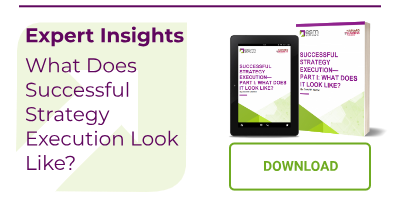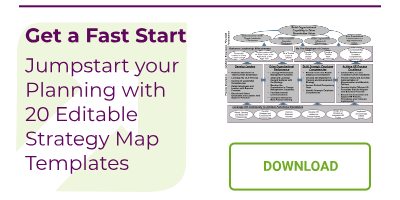 Part 2 of our 25th Anniversary Series
Part 2 of our 25th Anniversary Series
Think back to the late 1990s. Strategy was often a thick binder on a shelf, updated once a year and communicated, if at all, through cascading memos. Today we swipe through real‑time dashboards on our phones and join global stand‑ups from the kitchen table. Digital platforms mean anyone can spin up a product overnight and customers expect immediate, personalized experiences. The pace and transparency of business have shifted dramatically, but two things are still true: we need a clear destination and we struggle to turn vision into action.
This post takes you on a journey through the last quarter‑century of strategy and execution. We’ll explore what has changed, what has remained surprisingly constant, and why blending the balanced scorecard and OKR frameworks can help you bridge the gap between big‑picture thinking and day‑to‑day momentum. Along the way you’ll find practical suggestions and a bit of storytelling to help make the ideas stick.
How the environment has changed
Over the last 25 years the backdrop of business has been completely rewired. Here are some of the headline shifts:
- Speed and volatility – Thanks to the explosion of the internet and mobile computing, markets move faster than ever. Product cycles that once spanned years now run in months or even weeks. Strategies can no longer be written once a year and forgotten; they need to flex with constant feedback.
- Data abundance and transparency – Cloud‑based tools mean it’s possible for everyone to see the same numbers at the same time. Metrics that were once guarded by finance or IT might now be accessible to front‑line teams, making information flow far more transparent than in the 1990s.
- Flattened hierarchies and empowered teams – Agile, lean and design‑thinking methods have replaced many command‑and‑control structures. Instead of a centralized project office, execution is distributed across small, cross‑functional teams with the autonomy to make decisions.
- Greater employee engagement – Younger workers expect to know why they are doing their work. A shared purpose, consistent feedback and transparency are required to motivate and retain talent.
What hasn’t changed
Despite all the technological wizardry, some fundamentals of strategy have held steady:
- Vision and strategic direction still matter – Robert Kaplan and David Norton’s Balanced Scorecard research emphasizes that organizations must translate high‑level missions into specific objectives and targets. Even in a digital age, you still need to explain where your business is headed and why customers should care.
- Leadership and alignment remain critical – Kaplan notes that without strong leadership, strategies “fade from memory as the organization focuses on day‑to‑day operations”. Leaders must still carve out time for strategy discussions separate from operational firefighting.
- The execution gap persists – Many companies continue to treat strategy formulation and execution as separate activities. Kaplan warns that continuous improvement programs like Six Sigma often operate “with no sense of priorities or impact from process improvements”. Bridging that gap remains a universal challenge.
A quick refresher on the frameworks
Balanced Scorecard – strategy creation and alignment
Born in the early 1990s and popularized by Kaplan and Norton, the Balanced Scorecard (BSC) helps leaders move beyond purely financial goals and metrics. It combines financial and non‑financial measures in a concise report to capture the information most relevant to the organization. The genius of the BSC is that it forces you to translate lofty mission statements into tangible objectives that usually carry a 3-5 year time horizon across four perspectives – financial, customer, internal processes, and talent & technology. Designing a scorecard is a discipline: it involves translating the vision into operational goals, communicating the vision and linking it to individual performance, planning the business, and instituting feedback and learning loops so that you can adjust the goals and metrics to more closely align to the vision
Over the last two decades the BSC has evolved from a simple reporting tool into the centerpiece of a broader strategy management system. It helps organizations map cause‑and‑effect relationships, focus on a few strategic themes and align budgets and initiatives accordingly.
 While some organizations embraced OKRs and even abandoned their scorecards in pursuit of the latest management fad, experienced strategists note that the two frameworks serve different yet complementary purposes. Rather than discarding one for the other, we are seeing an increasing number of companies use the BSC to set long‑term strategic direction and then use OKRs to drive execution. Dan Montgomery, an OKR expert and author of Start Less, Finish More, explains that discovering objectives and key results gave him “the link between strategy and operational execution.” He describes OKRs as a simple, fast‑cadenced goal‑setting process that builds agility, employee engagement and learning while aligning objectives across the organization. At the same time, Montgomery cautions that there is no single prescription for strategy management—the tool you choose depends on the job you have to do. In this view, the Balanced Scorecard and OKRs are not mutually exclusive but can reinforce each other.
While some organizations embraced OKRs and even abandoned their scorecards in pursuit of the latest management fad, experienced strategists note that the two frameworks serve different yet complementary purposes. Rather than discarding one for the other, we are seeing an increasing number of companies use the BSC to set long‑term strategic direction and then use OKRs to drive execution. Dan Montgomery, an OKR expert and author of Start Less, Finish More, explains that discovering objectives and key results gave him “the link between strategy and operational execution.” He describes OKRs as a simple, fast‑cadenced goal‑setting process that builds agility, employee engagement and learning while aligning objectives across the organization. At the same time, Montgomery cautions that there is no single prescription for strategy management—the tool you choose depends on the job you have to do. In this view, the Balanced Scorecard and OKRs are not mutually exclusive but can reinforce each other.
OKR – agile execution
Objectives and Key Results (OKRs) were born at Intel in the 1970s and catapulted into the mainstream when venture capitalist John Doerr evangelized them in Measure What Matters. An objective expresses what you want to achieve; key results define how you’ll measure progress. Modern OKRs emphasize ambitious, “stretch” objectives coupled with just two to four measurable key results.
Why all the hype? Because OKRs bring clarity, accountability and transparency. They force teams to articulate what matters most and to measure progress weekly or monthly, driving focus and continuous improvement. They also foster engagement and alignment because everyone can see how their work connects to higher‑level objectives.
Real‑world adoption: The OKR methodology gained prominence when John Doerr highlighted it in Measure What Matters and showcased how it accelerated growth at companies like Google and Adobe. By aligning teams around a handful of ambitious, measurable objectives, these organizations improved focus and innovation, enabling them to scale rapidly in dynamic markets. Although specifics vary by company, the common thread is a culture that encourages employees to set daring objectives, track progress transparently and course‑correct frequently—practices that keep execution tightly aligned with strategy.
| Framework | Purpose & Focus | Key Differences |
| Balanced Scorecard | Translate vision into a coherent strategy and align the organization through financial and non‑financial objectives and measures across four perspectives. |
|
| OKR |
Align teams around a few ambitious objectives and measure progress through quantifiable key results. |
|
Despite their differences, both frameworks rely on metrics and data to track progress and aim to connect vision with action.
Using both frameworks together
Here’s the good news: you don’t have to choose between the BSC and OKRs. In fact, combining them can align long‑term strategy with short‑term actions. Industry commentators note that integrating OKRs with the Balanced Scorecard helps sync short‑term and long‑term goals, align stakeholders and provide a holistic view of performance. This blended approach balances agility and stability by linking daily execution to broader strategic objectives. Think of them as two gears that mesh beautifully when used in tandem:
- Start with the big picture – Use the Balanced Scorecard to define your mission, vision and long‑term outcomes. Identify strategic objectives across financial, customer, internal and talent and technology perspectives. Create a strategy map so employees can see the cause‑and‑effect relationships between objectives.
- Cascade into OKRs for execution – Once your long term strategic themes are clear, articulate no more than three to five high‑level objectives per theme. Invite departments and teams to co‑create their own OKRs that support these strategic objectives. Emphasize measurable key results so everyone knows what success looks like.
 Separate strategy and operations meetings – Kaplan & Norton advise holding monthly meetings dedicated to strategy, distinct from operational reviews. During strategy reviews, examine Balanced Scorecard metrics to assess whether initiatives are delivering the intended outcomes. During weekly or bi‑weekly operational check‑ins, look at OKR progress to ensure day‑to‑day activities align with strategic priorities.
Separate strategy and operations meetings – Kaplan & Norton advise holding monthly meetings dedicated to strategy, distinct from operational reviews. During strategy reviews, examine Balanced Scorecard metrics to assess whether initiatives are delivering the intended outcomes. During weekly or bi‑weekly operational check‑ins, look at OKR progress to ensure day‑to‑day activities align with strategic priorities.- Iterate and learn – BSC design stresses feedback and learning. OKRs promote frequent check‑ins and retrospectives. Together they encourage a learning culture: use data to identify what’s working, adjust your tactics and refine your strategy.
Reflections for today’s leader
If you’ve been in business long enough to remember dial‑up modems, you know that the execution landscape has shifted from static planning to agile learning. The Balanced Scorecard has matured into a proven tool for articulating longer term strategy and aligning the organization, while the rise of OKRs reflects a growing emphasis on empowerment, transparency and rapid iteration. What hasn’t changed is the need for strong leadership, clarity of purpose and the discipline to connect high‑level vision with day‑to‑day work.
Think of the BSC as your strategic compass and OKRs as the sprint shoes that get you moving. You don’t need to pick one set of tools and discard the other; what matters most is choosing an approach that fits your organization’s culture and helps people focus on what matters. Use the BSC to design your strategy and OKRs to deliver it, or mix and match elements of each to suit your needs. Together they help you honor timeless strategy principles while embracing the agility required in today’s digital age.
About ESM Software: ESM Software helps teams design, execute, measure and optimize their strategic plans with industry-leading software and coaching. Our integrated suite of cloud-based applications was built to meet your strategy and execution needs, with solutions for strategy management, risk/compliance, employee performance management, and operational scorecards.






